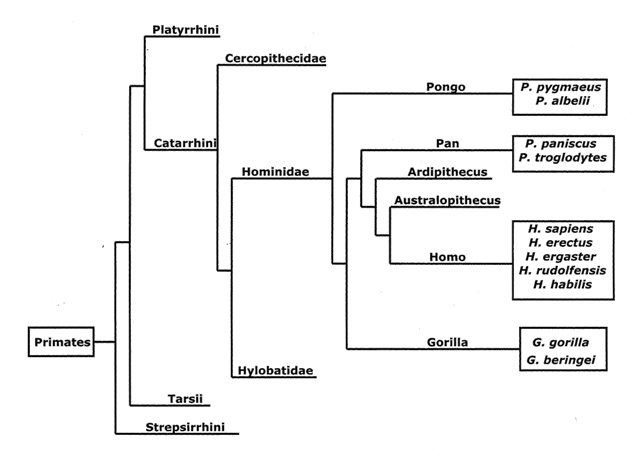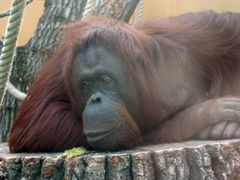Classification
Orangutan Taxonomy
| Domain: | Eukarya |
| Kingdom: | Animalia |
| Phylum: | Chordata |
| Class: | Mammalia |
| Order: | Primates |
| Family: | Hominidae |
| Genus: | Pongo |
| Species: | P. albelii or P. pygmaeus |
Orangutans are classified in the domain Eukarya because their cells contain a nucleus and membrane bound organelles, and they are multicellular organisms. In contrast, Prokaryotes are unicellular organisms (such as bacteria) that do not contain a cell nucleus or membrane bound organelles.
They belong to the kingdom Animalia because Orangutans are Heterotrophs that ingest food into an internal cavity. Organisms belonging to the kingdom Animalia also lack cell walls and are motile at some stage during their life cycle.
The phylum Chordata includes animals that possess a Notochord at some stage during their development. Other distinguishing characteristics are the presence of a tail and pharyngeal gill slits at some stage in development, a complete digestive system, bilateral symmetry, and a well developed Coelom.
Orangutans are contained in the class Mammalia because they are warm-blooded, possess hair on their body, have a four-chambered heart, and females produce milk from their mammary glands to nourish their young.
The order Primates has defining characteristics that are present in Orangutans such as the presence of differentiated tibia & fibula in the shank and ulna & radius in the forearm, presence of a clavicle, and possess five digit feet.
The family Hominidae exhibit both an opposable thumb and big toe (except humans), elimination of a tail, a large braincase, and flattened nails at the ends of the phalanges.
Orangutans are separated into the genus Pongo because they share less characteristics with humans than do Gorillas and Chimpanzees.
Orangutan Phylogeny
 Explanation
of Phylogenetic Tree Levels:
Explanation
of Phylogenetic Tree Levels:
Catarrhini: Humans, Great
Apes, and Old World Monkeys
Platyrrhini: New World Monkeys
Tarsii: Tarsiers
Strepsirrhini: Lemurs and Lorises
Cercopithecidae: Old World Monkeys
Hominidae: Humans, Gorillas, Chimpanzees,
Bonobos, and Orangutans
Hylobatidae: Gibbons
Pan: Chimpanzees and Bonobos
Ardipithecus: close relative of Humans
Australopithecus: close relative of Humans
Gorilla: Gorillas
Homo: Humans
Pongo: Orangutans
